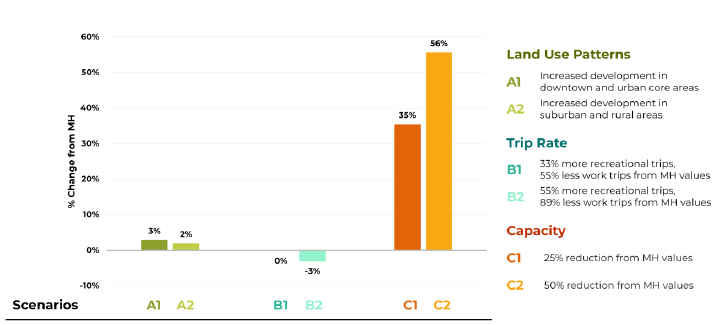NCDOT uses a data-driven process to inform the funding of transportation infrastructure. The primary analytical tool supporting this data-driven process is the travel demand model (TDM). The TDM is used to develop traffic forecasts that inform project decisions and the spending of tens of millions of dollars. The introduction and deployment of Connected and Automated Vehicles (CAVs) have the potential to significantly change traffic forecasts and may result in the Department unnecessarily spending tens of millions of dollars, or on the other hand, leave them unprepared for the disruption that CAVs may create in our transportation system.
This study focuses on the consideration of CAVs in TDMs and aims to provide guidance to NCDOT on the consideration of CAVs in travel demand models developed by or for NCDOT in support of transportation planning analysis and traffic forecasts across the state. Key findings from this research support the use of strategic scenario planning both within an existing model design (Tier 1) and design modifications (Tier 2) to evaluate the potential impact of CAVs on both system-level performance measures and project-level traffic forecasts. System level performance measures for both the Tier 1 and Tier 2 analysis showed increases in daily vehicle miles traveled (VMT) but decreases in congested VMT and delay for both a high (95%) and medium-high (70%) CAV adoption level. The project level analysis showed improvements in the demand-to-capacity ratio (D/C) and delay cost savings, but CAVs did not always indicate that project construction would no longer be necessary. The Tier 3 evaluation of NCDOT's Regional Travel Demand Model (RTDM) suggests first that CAV results may not be as intuitive in a small area with little congestion, but also that a deeper dive into the functionality and assumptions of this model is needed.
The study concludes that applying travel models in a scenario planning context is an effective way to understand the potential risks and benefits of CAVs on traffic forecasts. While model design (Tier 2) is the preferred method, this approach is more time and resource-intensive and requires a certain level of model development expertise. On the other hand, using an existing model (Tier 1) is an approach that could be implemented without delay on most, if not all, upcoming traffic forecasts. While not as realistic a representation of travel behavior, the results are shown to be an effective way to evaluate the risk and uncertainty of CAVs on transportation planning analysis and project-level traffic forecasts. NCDOT should move forward with the consideration of CAVs in traffic forecasts and long-range transportation plans with a forecast year of 2050 and beyond. NCDOT should also adopt a regular practice of risk and uncertainty analysis for traffic forecasts.

